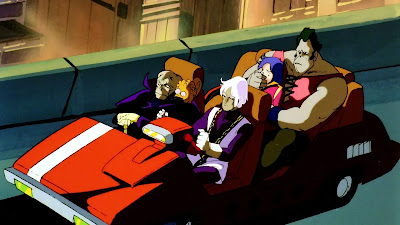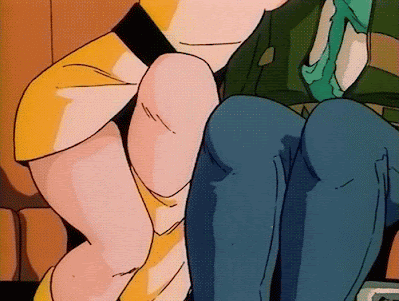 |
| The ultimate Animé superhero. |
Background.
Locke the Superman (超人ロック, Chōjin Rokku) is a manga series created by Yuki Hijiri, which was later adapted into a movie and three OVA releases. The movie was given an obscure video release in the United States by Celebrity Home Entertainment as Locke the Superpower,
which was rather heavily edited to 92 minutes, removing violence,
nudity and any adult bits. Both it and the OVAs were later licensed and
released by Central Park Media under the original name.
As of 2012, Discotek has licensed the original Locke the Superman film from 1984 and it was released on November 6. In November 2020, the original Locke the Superman film from 1984 was released on Blu-ray by Sentai Filmworks, and today's review will be about this wonderful 1980s animated movie.
 |
| The Japanese Blu-Ray set. |
 |
| The Blu-Ray cover art. |
Synopsis.
A quiet, polite, lonely immortal esper about which little is known, he
is called "Locke the Superman", but often denies being so. It is not
known where or when he was born, and if asked, Locke will say he does
not remember. It is entirely possible this is true. However, when asked
by Cornelia Prim in "Millennium of the Witch" which star he was from,
Locke replied "Toa."
He has appeared at various times throughout the history of the galaxy,
either as a direct influence, an indirect influence, or a simple
observer. Using his esper abilities, Locke can learn and do most things
more quickly than a normal human. His power also allows him to remain
eternally young, or even turn himself into a child again to be adopted
by kind-hearted families. It is speculated he remains youthful as an
excuse not to take responsibility for whatever cause he is approached
for, since no one expects youths to have such responsibilities.
 |
| Masked men. |
 |
| Innocent women. |
Review.
Locke The Superman is an excellent OVA. Regardless of the animation style that may upset newcomers, there's a solid story, great characters, lots of action and some early state-of-the-art 3D animation to show Japanese artists weren't fucking around when implementing this then new technology.
Produced by Nippon Animation, and directed by Fukutomi Hiroshi, who's known for his work on Captain Tsubasa, Doraemon, Fatal Fury,Gunnm & Lupin III, Locke The Superman is a movie that withstands time and could easily be seen as a "Superhero film" the likes we've seen in recent years. In a nutshell, Locke is an immortal super powered combination of Superman, Charles Xavier & a few other X-Men. Age wise, he's been around for centuries seeing how mankind has fallen for the vice of war time and time again. Obviously, the universe is on the brink of a new brutal war, only this time humanity won't stand a chance against it. Lady Kahn (the antagonist) has set out to train every Esper in the universe. Espers are humans with superhuman abilities. Most of them do what they do with their extremely developed mind powers, so if no regular John could stand a chance against one, imagine what it would be like standing against an army of enhanced superhumans. Ryu Yamaki (our heroes soon-to-be friend) knows this and starts a search for the legendary man that could turn the tables: Locke.
Animation wise, the film is flawless. Key animation, layout, character design and mecha design look amazingly good, and that's because the movie animation department was in charge of the late Kigami Yoshiji, who's known for his work in Cat's Eye, Crayon Shin-Chan, Macross: Do You Remember Love?, Space Adventure Cobra, among others.
 |
| I'm not into warfare, not interested. |
 |
| Love can be a deadly weapon. |
Plot wise, I think writers were quite clever to allow more on screen time to the secondary characters rather than focusing only on Locke's vision throughout the two hours the film runs. An overpowered being like our protagonist may feel linear, and too far to reach, too distant to care about his destiny. Ryu and Jessica are obviously there to provide our hero with a sense of responsibility over the weak, but Locke doesn't just stop there, that's why I think his nickname fits perfectly. Like Superman, Locke understands the responsibility of his special skills. He knows he's unique and that many would love to see him fight alongside their cause. Locke's humanity is precisely what makes him a character worth rooting for. An example of this can be when he encounters Cornelia Prim and her teams of expert Espers ready to fight him to death. Instead of dealing with them permanently, he prefers to disable them temporarily so that they can see he means no harm, and that is them who've been fooled into leading a senseless war. He wants them to be set free.
 |
| Cornelia Prim and her team. |
 |
| Esper training. |
 |
| The future has no pubes. |
 |
| Battle worn boobs. |
While this is a movie based on manga from the 1970s, it feels like there was an effort made here to update the art style a little bit. To an extent the character design is trying to bridge the gap between the 70s and the 80s, and it looks pretty good. Meanwhile, there is some very dynamic camera work going on in this movie. Fast, sweeping pans were quite popular, as well as a chase scene from the eyes of one of the people running. It was interesting to see such experimentation, and some of it looked good, while other parts were quite jarring.
It’s also worth taking a moment to mention this film's soundtrack, as it is fairly enjoyable. The music is a blend of orchestral pieces, rock guitar, outer space electronic bits, and the occasional funky track. The varying types of music are vaguely reminiscent of series like Space Battleship Yamato that had a similar feel to its soundtrack. People probably won’t find themselves humming the melodies to songs here but the music is still quite enjoyable nonetheless.
 |
| Can there be love in space? |
 |
| War is not the answer, and Locke knows it. |
In a nutshell, Much of the story involves traveling from planet to planet, trying to find the bad guys, sometimes resulting in a psychic fight between Locke and one of Lady Khan's trained pets. The action and plot are pretty straight forward and the two hour runtime feels shorter. One funny thing, is how the fanservice is delivered here. There's that obvious shower scene where Jessica reflects on her past and future, and that seems quite normal. People do take showers and think about their lives. However, some of the action scenes are just hilarious! Whenever female Espers take a beating, their "battle worn" clothes tear off just in their boobs area. This doesn't happen with Esper men. Perhaps their suits were made of lasting fabric or something. Now, this isn't a complaint of any kind, I just find it hilarious. In the future, shows like Aika would exploit this trope to the max while building a genre around panties and T&A. In Locke these scenes are brief and not overly used, because the writers wanted to provide you with that "dark and gritty" feature a lot of people used when talking about Anime in the late 80s and early 90s.
Now, speaking of the Blu Ray set, Locke The Superman is presented in 1080p High Definition and the
film was no doubt remastered as the series is vibrant and colorful, no
scratches and while it retains its original cel drawn animation and
beautiful backgrounds, the 3D scenes make it look like a more recent production.
The film is presented in Japanese DTS-HD MA 2.0. The soundtrack is
front speaker driven and dialogue and action are crystal clear.
Subtitles are in English.No lame dubs are included. Enjoy the voices of the original seiyuu.
The Blu-ray features the original Japanese promo for special features.
I must say, seeing old school Anime remastered in high definition is an incredible experience, it feels like you're watching these stories for the first time in your life. And for those old enough to have been around in the VHS tapes decade, you know what I'm talking about. Not even syndicated TV looked as pristine as HD remasters do.

Space travel safely. 
Solid designs.
The film was also nostalgic in the sense of how cel animation was used and the beauty of the painted backgrounds. But also the focus on storyline which I enjoyed.
This film has it all, action, romance, betrayal, violence, and also the common ’80s shower nudity that was prevalent in anime back in the day.
“Locke the Superman” is one of those titles that may have had a long run as a manga series, but unfortunately never had a long running anime series to go along with it.

Locke in action. 
The bad guys in action.
When the film was released, many fans were thrilled, while those in the US who watched it on video for the first time were a bit dismayed of the censorship which removed all the nudity and violence from the film.
What you get with the Sentai Filmworks version of the “Locke the Superman” release is the best version of the animated film to date which is on Blu-ray, uncut, remastered and for those clamoring for old school anime, it’s a title that I highly recommend!
Here's the US edition for movie trailer:Here's the French trailer:








































